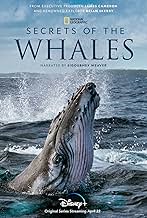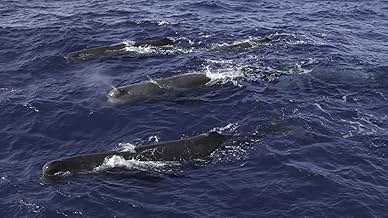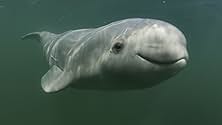PUNTUACIÓN EN IMDb
8,4/10
1,1 mil
TU PUNTUACIÓN
Filmada en 24 locaciones durante tres años, esta saga se adentra en el mundo de las ballenas para revelar la vida y el amor desde su perspectiva y explora las culturas de las orcas, belugas,... Leer todoFilmada en 24 locaciones durante tres años, esta saga se adentra en el mundo de las ballenas para revelar la vida y el amor desde su perspectiva y explora las culturas de las orcas, belugas, narvales, cachalotes y ballenas jorobadas.Filmada en 24 locaciones durante tres años, esta saga se adentra en el mundo de las ballenas para revelar la vida y el amor desde su perspectiva y explora las culturas de las orcas, belugas, narvales, cachalotes y ballenas jorobadas.
- Ganó 1 premio Primetime Emmy
- 1 premio y 4 nominaciones en total
Explorar episodios
Reseñas destacadas
Secrets of the Whales
With Sigourney Weaver's soothing voice, excellent cinematography, and education on these majestic creatures, this Nat Geo miniseries shows off Orcas, Humpbacks, Belugas, Narwhals and Sperm Whales up close and personal. They do show them feeding, but from a distance, and not the super gory way it truly is. I felt bad for those poor sea lions.
The footage from underwater is just so cool to see. The divers did a really good job for those shots.
I mean, it's a documentary about whales, so it's pretty straightforward, but I enjoyed seeing the creatures that are usually seen from a distance.
With Sigourney Weaver's soothing voice, excellent cinematography, and education on these majestic creatures, this Nat Geo miniseries shows off Orcas, Humpbacks, Belugas, Narwhals and Sperm Whales up close and personal. They do show them feeding, but from a distance, and not the super gory way it truly is. I felt bad for those poor sea lions.
The footage from underwater is just so cool to see. The divers did a really good job for those shots.
I mean, it's a documentary about whales, so it's pretty straightforward, but I enjoyed seeing the creatures that are usually seen from a distance.
10rannynm
Have you ever been told that our oceans are very mysterious and that they hold many secrets that are likely to be hidden forever? Well, that's certainly true - our oceans are indeed mysterious and some of the most amazing secrets hidden deep within our oceans have recently been discovered and are ready to be shared with the world in a new National Geographic four-part documentary series. Secrets of the Whales spotlights four species of whales and uncovers their secrets and stories of survival with "first time" evidence and never-before-seen coverage. This series is epic and one you are going to want to witness!
Secrets of the Whales brings alive the visions of both Academy Award winning filmmaker and conservationist James Cameron and acclaimed National Geographic Explorer and Photographer Brian Skerry as they share their knowledge and research finding of some of the most intelligent giants living on our planet. Filmed across three years and in 24 locations, this documentary series, narrated by award-winning actress Sigourney Weaver, takes viewers on an amazing journey into the lives of orcas, humpbacks, belugas, and sperm whales. From Cameron and Skerry's work we gain such an expansive understanding and appreciation of whale family dynamics, social bonds, communication and tradition. It's the "secrets these mammals share which help them prevail."
This series has me completely captivated throughout all four episodes. Seeing the variety of marine life within their natural habitat is just jaw-dropping. With such stunning photography and action-packed video footage, the cinematography in Secret of the Whales is the best I've ever seen. As each scene is presented to viewers, you get a sense of being right there and consumed within each moment. To pick a favorite episode within this series would be impossible, since each episode is so unique with new secrets of the whales being unveiled to viewers.
The common message within all four episodes of Secrets of the Whales is centered around culture.
These whale families must work together in a sophisticated manner if they are going to survive and be successful as a species. Whales are highly evolved creatures that have the complexity of family bonds, language, feeding patterns, emotions and interesting secrets. It is critical that these traditions be taught to offspring and passed down throughout the generations.
I give Secrets of the Whales 5 out of 5 stars and recommend it for ages 8 to 18. Adults, especially those interested in marine ecology and conservation will certainly appreciate these films as well. What a great way to celebrate Earth Day. Don't miss this series! Reviewed by Dominic D., KIDS FIRST!
Secrets of the Whales brings alive the visions of both Academy Award winning filmmaker and conservationist James Cameron and acclaimed National Geographic Explorer and Photographer Brian Skerry as they share their knowledge and research finding of some of the most intelligent giants living on our planet. Filmed across three years and in 24 locations, this documentary series, narrated by award-winning actress Sigourney Weaver, takes viewers on an amazing journey into the lives of orcas, humpbacks, belugas, and sperm whales. From Cameron and Skerry's work we gain such an expansive understanding and appreciation of whale family dynamics, social bonds, communication and tradition. It's the "secrets these mammals share which help them prevail."
This series has me completely captivated throughout all four episodes. Seeing the variety of marine life within their natural habitat is just jaw-dropping. With such stunning photography and action-packed video footage, the cinematography in Secret of the Whales is the best I've ever seen. As each scene is presented to viewers, you get a sense of being right there and consumed within each moment. To pick a favorite episode within this series would be impossible, since each episode is so unique with new secrets of the whales being unveiled to viewers.
The common message within all four episodes of Secrets of the Whales is centered around culture.
These whale families must work together in a sophisticated manner if they are going to survive and be successful as a species. Whales are highly evolved creatures that have the complexity of family bonds, language, feeding patterns, emotions and interesting secrets. It is critical that these traditions be taught to offspring and passed down throughout the generations.
I give Secrets of the Whales 5 out of 5 stars and recommend it for ages 8 to 18. Adults, especially those interested in marine ecology and conservation will certainly appreciate these films as well. What a great way to celebrate Earth Day. Don't miss this series! Reviewed by Dominic D., KIDS FIRST!
The content is interesting to watch. However, as you listen to the narration, 99% of whales are females. Whenever there was ever a "he", it was only presented in a sort of futile attempt at something. I never imagined that the liberal female lead bias could be extended even to program about animals.
Each episode was beautifully produced and narrated but I was absolutely shocked that National Geographic presented an episode that refers to the Orca/"Killer Whale" as a whale. It's not a whale. It's the largest Dolphin, which is an entirely different animal.
I read a lot of the other reviews and noted almost every one of them commented on how much they learned. Wouldn't it be better to have said from the top that it's called the Killer Whale but it isn't actually a whale. Makes me wonder what else they put in the series that isn't correct.
National Geographic is known for it's gold standard. Why would you let this one slip through? Or did you reclassify the Orca without announcing it?
I read a lot of the other reviews and noted almost every one of them commented on how much they learned. Wouldn't it be better to have said from the top that it's called the Killer Whale but it isn't actually a whale. Makes me wonder what else they put in the series that isn't correct.
National Geographic is known for it's gold standard. Why would you let this one slip through? Or did you reclassify the Orca without announcing it?
Greetings again from the darkness. For many of us, our exposure to whales is limited to learning in school they are the largest mammals on Earth, and browsing travel guides displaying fantastic photographs of breeching whales alongside various tour excursions. National Geographic is on a mission to take us deeper into the world of these marvelous marine creatures. This 4-part docuseries is Executive Produced by Oscar-winning director James Cameron and award-winning photographer Brian Skerry, and was filmed over 3 years in multiple locations around the globe.
Episode One is titled "Orca Dynasty", and it explores communication and social structure that occurs within the family pod and community ... a recurring theme in each of the episodes, and across the five types of whales covered. Orcas, sometimes referred to as "killer whales", are the gorgeous black and white whales often featured at water parks ... although thankfully not as frequently as in the past. This segment takes us to New Zealand where we see the Orcas work together in hunting stingray, and utilize sophisticated sonar as their guide. We also follow them to the frigid water of the Arctic Ocean, as well as their confrontations with elephant seals in The Falklands.
Episode Two, "Humpback Song", features a baby learning to "speak", and again focuses on the culture and communication of the humpbacks. We witness these whales using their large brains for "bubblenet" fishing in Alaska - a highly coordinated effort that has been occurring for 40-plus years. The humpbacks breech and then slap their fin to communicate with each other. Their 'song of the sea' is featured in the Cook Islands, and we see the bonding that occurs between mother and calf. It's awe-inspiring to note that 100,000 whales from around the world simultaneously head to Antarctica for a krill buffet that results in each whale gaining up to 12 pounds an hour!
In Episode Three, "Beluga Kingdom", we follow along as these creamy white whales and their exceptionally social manner, adopt a stray narwhal whale into their pod so that it doesn't die alone. The narwhals are the most unusual looking whale in existence, even in comparison to the Belugas. With skin 100 times thicker than humans, Belugas are also known for group births, and generations of Belugas have spent one-third of their summers in Hudson Bay (Canada).
The fourth and final episode, "Ocean Giants" focuses on the massive sperm whales, best known as "Moby Dick". We learn their brains are six times larger than humans, and they use a Morse Code style clicking sound to communicate with each other. In Dominica (eastern Caribbean) we find 20 sperm whale families who deep dive to feed on 100 squid per day. This segment also includes the often tragic ramifications of human debris in the ocean, as sea turtles are entangled in discarded fishing nets.
Photography throughout the series is stunning and breath-taking. It takes us to places we never knew existed or might have previously only dreamt of. The only downside is the narration from Sigourney Weaver, whose lack of energy in reading, periodically gives this the sound of an old-school educational film. James Cameron provides an epilogue for each episode, but without a doubt, it's the fabulous creatures themselves that hold our attention. We find the Orcas, Humpbacks, Belugas, Narwhals, and Sperm Whales to be awe-inspiring and mesmerizing, and it's fascinating to learn how intricate and complex their social structures and cultures are. These intelligent giants of the sea draw us right into their world; and we are better off for it.
Disney+ original series Secrets of the Whales, from National Geographic, premieres Earth Day, April 22, 2021. The three-year project will also be featured in the new National Geographic book Secrets of the Whales, on sale April 6, and the May issue of National Geographic magazine, The Ocean Issue, available online on April 15.
Episode One is titled "Orca Dynasty", and it explores communication and social structure that occurs within the family pod and community ... a recurring theme in each of the episodes, and across the five types of whales covered. Orcas, sometimes referred to as "killer whales", are the gorgeous black and white whales often featured at water parks ... although thankfully not as frequently as in the past. This segment takes us to New Zealand where we see the Orcas work together in hunting stingray, and utilize sophisticated sonar as their guide. We also follow them to the frigid water of the Arctic Ocean, as well as their confrontations with elephant seals in The Falklands.
Episode Two, "Humpback Song", features a baby learning to "speak", and again focuses on the culture and communication of the humpbacks. We witness these whales using their large brains for "bubblenet" fishing in Alaska - a highly coordinated effort that has been occurring for 40-plus years. The humpbacks breech and then slap their fin to communicate with each other. Their 'song of the sea' is featured in the Cook Islands, and we see the bonding that occurs between mother and calf. It's awe-inspiring to note that 100,000 whales from around the world simultaneously head to Antarctica for a krill buffet that results in each whale gaining up to 12 pounds an hour!
In Episode Three, "Beluga Kingdom", we follow along as these creamy white whales and their exceptionally social manner, adopt a stray narwhal whale into their pod so that it doesn't die alone. The narwhals are the most unusual looking whale in existence, even in comparison to the Belugas. With skin 100 times thicker than humans, Belugas are also known for group births, and generations of Belugas have spent one-third of their summers in Hudson Bay (Canada).
The fourth and final episode, "Ocean Giants" focuses on the massive sperm whales, best known as "Moby Dick". We learn their brains are six times larger than humans, and they use a Morse Code style clicking sound to communicate with each other. In Dominica (eastern Caribbean) we find 20 sperm whale families who deep dive to feed on 100 squid per day. This segment also includes the often tragic ramifications of human debris in the ocean, as sea turtles are entangled in discarded fishing nets.
Photography throughout the series is stunning and breath-taking. It takes us to places we never knew existed or might have previously only dreamt of. The only downside is the narration from Sigourney Weaver, whose lack of energy in reading, periodically gives this the sound of an old-school educational film. James Cameron provides an epilogue for each episode, but without a doubt, it's the fabulous creatures themselves that hold our attention. We find the Orcas, Humpbacks, Belugas, Narwhals, and Sperm Whales to be awe-inspiring and mesmerizing, and it's fascinating to learn how intricate and complex their social structures and cultures are. These intelligent giants of the sea draw us right into their world; and we are better off for it.
Disney+ original series Secrets of the Whales, from National Geographic, premieres Earth Day, April 22, 2021. The three-year project will also be featured in the new National Geographic book Secrets of the Whales, on sale April 6, and the May issue of National Geographic magazine, The Ocean Issue, available online on April 15.
¿Sabías que...?
- ConexionesFeatured in AniMat's Crazy Cartoon Cast: The Rat of All My Dreams (2020)
Selecciones populares
Inicia sesión para calificar y añadir a tu lista para recibir recomendaciones personalizadas
- How many seasons does Secrets of the Whales have?Con tecnología de Alexa
Detalles
- Fecha de lanzamiento
- País de origen
- Sitio oficial
- Idioma
- Títulos en diferentes países
- Secrets of the Whales
- Localizaciones del rodaje
- Empresas productoras
- Ver más compañías en los créditos en IMDbPro
- Duración3 horas 11 minutos
- Color
- Mezcla de sonido
- Relación de aspecto
- 16:9 HD
Contribuir a esta página
Sugerir un cambio o añadir el contenido que falta

Principal laguna de datos
What is the Japanese language plot outline for Secretos de las ballenas (2021)?
Responde


























